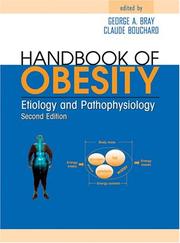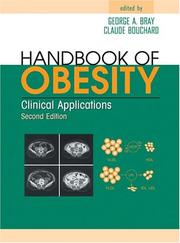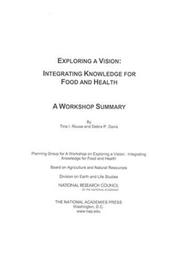| Listing 1 - 10 of 16 | << page >> |
Sort by
|
Book
Year: 2004 Publisher: [Bethesda, MD] : National Institute of Diabetes and Digestive and Kidney Diseases, National Institutes of Health,
Abstract | Keywords | Export | Availability | Bookmark
 Loading...
Loading...Choose an application
- Reference Manager
- EndNote
- RefWorks (Direct export to RefWorks)
Obesity --- Body weight --- Health aspects

ISBN: 9780824709693 0824709691 Year: 2004 Publisher: New York (N.Y.) Dekker
Abstract | Keywords | Export | Availability | Bookmark
 Loading...
Loading...Choose an application
- Reference Manager
- EndNote
- RefWorks (Direct export to RefWorks)
Obesity --- Obésité --- Obesity. --- Body Weight --- Hyperphagia --- Weight Gain --- Bariatrics --- Obésité --- Obesity Management --- Adiposity --- Corpulence --- Fatness --- Overweight --- Body weight --- Metabolism --- Nutrition disorders --- Disorders

ISBN: 0824747739 Year: 2004 Publisher: New York (N.Y.) Dekker
Abstract | Keywords | Export | Availability | Bookmark
 Loading...
Loading...Choose an application
- Reference Manager
- EndNote
- RefWorks (Direct export to RefWorks)
Obesity. --- 572.511 --- 572.512 --- Body Weight --- Hyperphagia --- Weight Gain --- Bariatrics --- Posture. Corpulence. Steatopygia --- Measurements and proportions of the body. Dimensions --- 572.511 Posture. Corpulence. Steatopygia --- Obesity --- Obesity Management --- Adiposity --- Corpulence --- Fatness --- Overweight --- Body weight --- Metabolism --- Nutrition disorders --- Disorders
Article
Abstract | Keywords | Export | Availability | Bookmark
 Loading...
Loading...Choose an application
- Reference Manager
- EndNote
- RefWorks (Direct export to RefWorks)
Objective-To determine whether race history, including the number of races and total race distance, was associated with risk of superficial digital flexor tendon (SDFT) injury in Thoroughbred racehorses in Japan. Design-Matched case-control study. Animals-515 Thoroughbred racehorses (case horses) that sustained an SDFT injury during training or racing in Japan during 2002 and 951 horses (control horses) without SDFT injury that were matched with case horses on the basis of age and month of the latest race. Procedure-Variables related to race history were compared between case and control horses by means of conditional logistic regression. Results-The odds of SDFT injury increased as mean race distance and mean body weight at race time increased. Compared with females that had never competed in steeplechase races, males regardless of steeplechase race history and females that had competed in steeplechase races had higher odds of SDFT injury. Conclusions and Clinical Relevance-Results suggest that longer mean distance per race, heavier mean body weight at race time, steeplechase experience, and sex (male) increased the risk of SDFT injury in Thoroughbred racehorses
Age. --- Association. --- Body weight. --- Body-weight. --- Control. --- Distance. --- Equine. --- Experience. --- Fatalities. --- Female. --- Females. --- History. --- Horse. --- Horses. --- Hyperthermia. --- Injuries. --- Injury. --- Male. --- Males. --- Musculoskeletal injuries. --- Prevalence. --- Racehorse. --- Risk. --- Sex. --- Sexes. --- Thoroughbred. --- Time. --- Training. --- Weight.
Periodical
Abstract | Keywords | Export | Availability | Bookmark
 Loading...
Loading...Choose an application
- Reference Manager
- EndNote
- RefWorks (Direct export to RefWorks)
Body weight --- Metabolism --- Nutrition disorders --- Weight Gain. --- Obesity --- Weight Perception. --- Body weight. --- Nutrition disorders. --- Disorders --- psychology. --- Disorders. --- Disorders of nutrition --- Disorders of metabolism --- Metabolic diseases --- Metabolic disorders --- Metabolism, Disorders of --- Perception, Weight --- Perceptions, Weight --- Weight Perceptions --- Gain, Weight --- Gains, Weight --- Weight Gains --- Anabolism --- Catabolism --- Metabolism, Primary --- Primary metabolism --- Diseases --- Anthropometry --- Body size --- Weights and measures --- Body composition --- Weight gain --- Weight loss --- Biochemistry --- Physiology
Article
Abstract | Keywords | Export | Availability | Bookmark
 Loading...
Loading...Choose an application
- Reference Manager
- EndNote
- RefWorks (Direct export to RefWorks)
The provision of foraging opportunities may be a simple way of improving an animal's welfare, but this approach has been neglected for laboratory rats (Rattus norvegicus). Standard housing contains little enrichment and food is often provided ad libitum, which may result in inactivity and obesity, especially in mature males. Foraging enrichments may offer a way to correct these deficiencies. This study compared three potential enrichments - a limited-access hopper, gnawing sticks and a foraging device - to standard housing and feeding conditions, in order to examine their effects on rat body weight food consumption, behaviour and preferences. The subjects were 12 mature male Wistar rats. Effects were assessed from daily weighing and from video records of the rats' behaviour over 24 h periods. The rats' preferences were determined using a four-way test system in which they could choose between a standard cage and cages offering the three potential enrichments. Compared to the standard housing and feeding, the limited-access hopper had a tendency to reduce food consumption, but the time spent feeding increased The gnawing sticks provided the rats with the opportunity to gnaw, but did not affect other behaviours or body weight. The foraging device had the benefits of reducing aggression and allowing the rats to search for and manipulate food, but resulted in significant gains in body weight. Additionally, the foraging device was the preferred feeding source. Of the four possible feeding locations, the rats spent the least amount of time in the standard cage. The foraging device provided the most benefits but requires further modification to address problems of obesity
Ad-libitum. --- Aggression. --- Animal welfare. --- Animal-welfare. --- Animal. --- Behavior. --- Behaviour. --- Body weight. --- Body-weight. --- Cage. --- Cages. --- Device. --- Enrichment. --- Environmental enrichment foraging. --- Feeding. --- Food. --- Foraging. --- Housing. --- Inactivity. --- Laboratory rat. --- Laboratory rats. --- Laboratory. --- Male. --- Males. --- Meal patterns. --- Mongolian gerbil. --- Nesting materials. --- Old. --- Periods. --- Preference. --- Preferences. --- Procurement cost. --- Provision. --- Rat. --- Rats. --- Rattus norvegicus. --- Rattus-norvegicus. --- Search. --- Social contact. --- System. --- Test. --- Time. --- Video. --- Weight. --- Welfare. --- Wistar rats.

ISBN: 0309090571 0309527058 9780309527057 9780309090575 0309166365 9780309166362 Year: 2004 Publisher: Washington, D.C. National Academies Press
Abstract | Keywords | Export | Availability | Bookmark
 Loading...
Loading...Choose an application
- Reference Manager
- EndNote
- RefWorks (Direct export to RefWorks)
Nutrition --- Public health --- Food consumption --- Health planning --- Obesity --- Research --- Health aspects --- Consumption of food --- Adiposity --- Corpulence --- Fatness --- Overweight --- Cost and standard of living --- Food supply --- Body weight --- Metabolism --- Nutrition disorders --- Disorders
Article
Abstract | Keywords | Export | Availability | Bookmark
 Loading...
Loading...Choose an application
- Reference Manager
- EndNote
- RefWorks (Direct export to RefWorks)
Social isolation can induce psychological behavior changes. It is interesting to know whether there is sex difference in responding to social isolation or not. The present study compared the behavior difference between male and female mice isolated for 1-4 months. The results showed that the isolated male mice had higher accounts of locomotor activity than the isolated female and group-housed ones. Both isolated male and female mice spent shorter time in the dark box than the group-housed mice in the light/dark test, and isolated male mice spent less time in the closed arms than isolated female and group-housed mice when isolated for 2, 3 and 4 months in the elevated plus-maze test. These results suggest that isolation induce an anxiolytic-like effect. The immobile time in the forced swimming test was shortened in male mice isolated for 1 and 2 months. Both isolated male and female mice showed shorter time in pentobarbital-induced loss of righting reflex and less body weight gain. These results demonstrated that there was a sex difference in psychological behavior changes in mice undergoing social isolation and the male mice were more easily affected by isolation. (C) 2003 Elsevier Inc. All rights reserved
Activity. --- Antidepressant. --- Anxiety. --- Anxiolytic-like. --- Behavior. --- Behavioral despair. --- Benzodiazepines. --- Body weight. --- Body-weight. --- Boxes. --- Elevated plus maze. --- Elevated plus-maze test. --- Elevated plus-maze. --- Female mice. --- Female. --- Induced decrease. --- Involvement. --- Isolation stress. --- Isolation. --- Light/dark test. --- Locomotor activity. --- Locomotor-activity. --- Long-term. --- Male-mice. --- Male. --- Mice. --- Model. --- Pentobarbital sleep. --- Pentobarbital-induced sleeping time. --- People. --- Reflex. --- Review. --- Righting. --- Sex difference. --- Sex. --- Sexes. --- Social isolation. --- Social-isolation. --- Social. --- Swimming. --- Test. --- Time. --- Weight gain. --- Weight. --- Wistar rats.
Article

Year: 2004
Abstract | Keywords | Export | Availability | Bookmark
 Loading...
Loading...Choose an application
- Reference Manager
- EndNote
- RefWorks (Direct export to RefWorks)
In socially unstable groups of male laboratory mice, individuals may experience a chronic stress situation. Previous experiments have shown that the transfer of specific olfactory cues during cage cleaning, and the provision of nesting material decrease aggression and stress in group-housed male mice. In this study, the combined effect of these husbandry procedures were tested for their long-term effect on stress in groups of moderately aggressive (BALB/c) and severely aggressive (CD-1) male mice. The physiological and behavioural stress-related parameters used were body weight, food and water intake, spleen and thymus weight, adrenal tyrosine hydroxylase activity, urine corticosterone levels and behaviour in a cage emergence test. Long-term provision of nesting material and its transfer during cage cleaning was found to influence several stress-related physiological parameters. Mice housed in cages enriched with nesting material had lower urine corticosterone levels and heavier thymuses, and they consumed less food and water than standard-housed mice. Furthermore, marked differences were found between strains. CD-1 mice were less anxious in the cage emergence test, weighed more, ate and drank more, and had heavier thymuses but lighter spleens and lower corticosterone levels than BALB/c mice. We conclude that the long-term provision of nesting material, including the transfer of nesting material during cage cleaning, reduces stress and thereby enhances the welfare of laboratory mice
Activity. --- Adrenal tyrosine hydroxylase. --- Adrenal. --- Aggression. --- Aggressive-behavior. --- Aggressive. --- Behaviour. --- Body weight. --- Body-weight. --- Cage. --- Cages. --- Chronic stress. --- Cleaning. --- Corticosterone levels. --- Corticosterone. --- Cues. --- Enriched. --- Environmental enrichment. --- Experience. --- Experiment. --- Experiments. --- Food. --- Group. --- Husbandry. --- Inbred strains. --- Laboratory mice. --- Laboratory. --- Level. --- Long-term. --- Male dba/2j mice. --- Male laboratory mice. --- Male mice. --- Male-mice. --- Male. --- Mice. --- Modulation. --- Mouse. --- Nesting material. --- Olfactory cues. --- Olfactory. --- Parameters. --- Physiological. --- Provision. --- Rats. --- Stress. --- Test. --- Time. --- Tyrosine-hydroxylase. --- Tyrosine. --- Urine. --- Weight. --- Welfare.

ISBN: 1281934763 9786611934767 9812794875 9789812794871 9781281934765 9789812387387 9812387382 9812387382 Year: 2004 Publisher: Singapore River Edge, N.J. World Scientific
Abstract | Keywords | Export | Availability | Bookmark
 Loading...
Loading...Choose an application
- Reference Manager
- EndNote
- RefWorks (Direct export to RefWorks)
Slimming and dieting has become such a fixation among Singaporeans that manufacturers and distributors of weight-reducing products are laughing all the way to the bank. However, the recent spate of controversies surrounding slimming pills is no laughing matter. This book is a collection of articles accessible to anyone who wants to know more about the phenomenon, its consequences and related topics. Its purpose is not to champion the "ideal" of being slim, but rather to provide a platform for meaningful discussion and for educating the general public about a healthier way of living. Written by
Weight loss --- Reducing diets --- Obesity --- Body image --- Image, Body --- Imagery (Psychology) --- Mind and body --- Person schemas --- Personality --- Self-perception --- Human body --- Adiposity --- Corpulence --- Fatness --- Overweight --- Body weight --- Metabolism --- Nutrition disorders --- Dieting for weight loss --- Diet --- Dieters --- Losing weight --- Loss of weight --- Reducing --- Reduction of weight --- Slimming --- Weight control of obesity --- Weight reducing --- Weight reduction --- Social aspects --- Disorders --- Diet therapy --- Control
| Listing 1 - 10 of 16 | << page >> |
Sort by
|

 Search
Search Feedback
Feedback About UniCat
About UniCat  Help
Help News
News